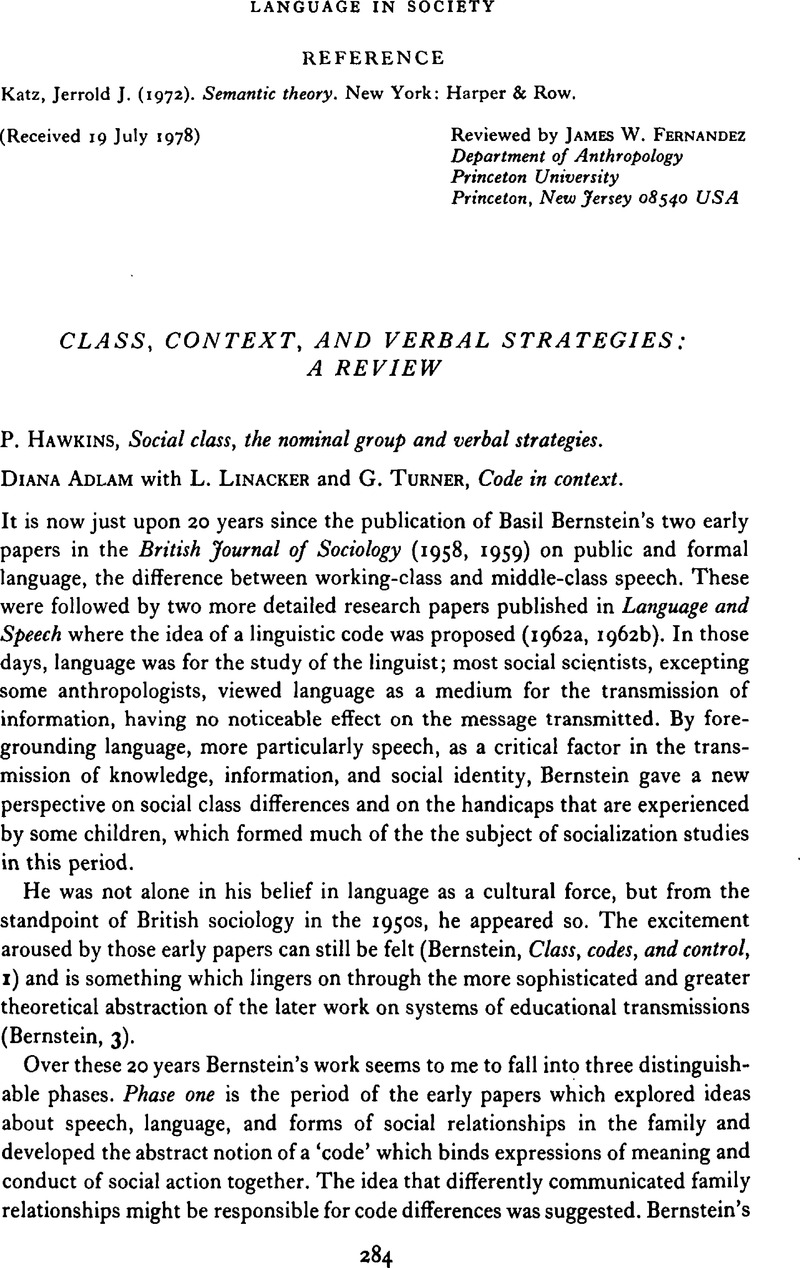No CrossRef data available.
Article contents
Class, Context, and Verbal Strategies: A Review - P. Hawkins, Social class, the nominal group and verbal strategies. - Diana Adlam with L. Linacker and G. Turner, Code in context.
Review products
P. Hawkins, Social class, the nominal group and verbal strategies.
Diana Adlam with L. Linacker and G. Turner, Code in context.
Published online by Cambridge University Press: 18 December 2008
Abstract
An abstract is not available for this content so a preview has been provided. Please use the Get access link above for information on how to access this content.

Information
- Type
- Book Review
- Information
- Copyright
- Copyright © Cambridge University Press 1979
References
REFERENCES
Bernstein, B. (1958). Some sociological determinants of perception. An inquiry into subcultural differences. British Journal of Sociology, 9.CrossRefGoogle Scholar
Bernstein, B. (1959). A public language: Some sociological implications of a linguistic form. British Journal of Sociology, 10.CrossRefGoogle Scholar
Bernstein, B. (1962a). Social class, linguistic code and grammatical elements. Language and Speech, 5.CrossRefGoogle Scholar
Bernstein, B. (1962b) Linguistic codes, hesitation phenomena and intelligence. Language and Speech, 5.CrossRefGoogle Scholar
Bossard, J. (1945). Family modes of expression. In Bossard, J. & Boll, E. (eds), (1966). The sociology of child development. New York: Harper International.Google Scholar
Brandis, W. & Henderson, D. (1970). Social class, language and communication. London: Routledge & Kegan Paul.Google Scholar
Cole, M., Dore, J., Hall, W. S. & Dowley, G. (1977). Situation and task in young children's talk. Working Paper 7. Lab, of Comparative Human Cognition & Institute for Comparative Human Development. New York: Rockefeller University.Google Scholar
Cook-Gumperz, J. (1973). Socialization and social control. London: Routledge & Kegan Paul.Google Scholar
Davis, A. & Havighurst, R. (1946). Social class and color differences in child-rearing. American Sociological Review, 11.CrossRefGoogle Scholar
Davis, A. (1948). Social class influences upon social learning. Cambridge, Mass.: Harvard University Press.Google Scholar
Edwards, A. D. (1976). Language in culture and class. London: Heinemann Educational Books.Google Scholar
Gahagan, D. (1970). Talk reform: Explorations in language for infant school children. London: Routledge & Kegan Paul.Google Scholar
Goody, J. R. (1977). Domestication of the savage mind. London: Cambridge University Press.Google Scholar
Halliday, M. A. K. (1976). Ideas about language. Inaugural lecture delivered at the University of Sydney, Australia.Google Scholar
Hawkins, P. R. (1977). Social class, the nominal group, and verbal strategies. Boston: Routledge & Kegan Paul.Google Scholar
Holton, G. (1973). Thematic origins of scientific thought. Cambridge, Mass.: Harvard University Press.Google Scholar
Mehan, H. (1974). Assessing children's language-using abilities. In Armour, M. & Grimshaw, A. (eds), Comparative social research: Methodological problems and strategies. New York: John Wiley & Sons.Google Scholar
Mills, C. W. (1939). Language logic and culture. American Sociological Review, 4.CrossRefGoogle Scholar
Mills, C. W. (1940). Situated actions and vocabularies of motive. American Sociological Review, 4.Google Scholar
Robinson, W. & Rackstraw, S. (1971). A question of answers. London: Routledge & Kegan Paul.Google Scholar
Schatzmann, L. & Strauss, A. (1955). Social class and modes of communication. American Journal of Sociology, 60.CrossRefGoogle Scholar
Turner, G. & Mohan, B. (1970). A linguistic description and computer programme for children's speech. London: Routledge & Kegan Paul.Google Scholar

